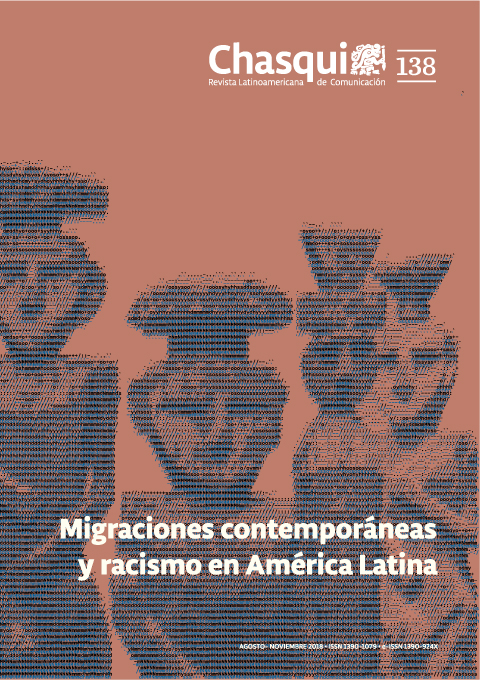Retórica mediática y migración. Las representaciones de la migración en las narrativas post 9/11 del New York Times
DOI:
https://doi.org/10.16921/chasqui.v0i138.3630Palabras clave:
ilegal, mexicanos, noticias, Estados Unidos, discurso, terrorismoResumen
Como una institución cultural, la prensa juega un papel fundamental documentando y forjando la imagen pública sobre los migrantes. Este trabajo analiza dos ejes temáticos en la narrativa post 9/11 del periódico New York Times sobre la migración. La imagen que se creó durante el año posterior a los ataques terroristas presenta por un lado al migrante mexicano como un terrorista en potencia y por otro lado a la migración como un problema global. Es fundamental problematizar la retórica sobre la migración contemporánea insertándola en las raíces ideológicas que definieron ese momento y en el marco histórico de la relación México-Estados Unidos. La retórica mediática post 9/11 contribuyó al surgimiento de una nueva agenda internacional al globalizar esta representación.Referencias
Almaguer, T. (1993). Racial Fault Lines: The Historical Origins of White Supremacy in California. Berkley: University of California Press.
Bhabha, H. & Comaroff, J. (2002). Speaking of Postcoloniality, in the Continuous Present: A Conversation. In Goldberg, D. T. & Quayson, A. (ed.) Relocating Postcolonialism. Blackwell Publishers.
Carvalho, A. (2008). Media(ted) Discourse and Society. Journalism Studies, 9: 2, 161-177.
Castells, M. (2000). The Rise of the Network Society. (2nd ed.). Oxford; Malden, Mass.: Blackwell Publishers.
Conklin Frederking, L. (2012). A comparative study of framing immigration policy after 11 September 2001. Policy Studies, 33:4, 283-296.
Chavez, L. R. (2001). Covering immigration: Popular images and the politics of the nation. Berkeley and Los Angeles: University of California Press.
Chavez, L. R. (2008). The Latino threat: Constructing immigrants, citizens, and the nation. Stanford: Stanford University Press.
De Genova, N. (2002). Migrant "Illegality" and Deportability in Everyday Life. Annual Review Anthropology. 31:419-47.
Entman, R. M. (1993). Framing: Toward Clarification of a Fractured Paradigm. Journal of Communication 43(4), Autumn.
Erlanger, S. (2002, June 21). European Summit Talks Open Today; Focus Is Immigration Control. The New York Times. https://nyti.ms/2Npz4GM.
Guild, E. (2003). International terrorism and EU immigration, asylum and borders policy: the unexpected victims of 11 September 2001. European Foreign Affairs Review. 8.3 (Autumn 2003): p. 331.
Gutiérrez, D. (1995). Walls and Mirrors: Mexican Americans, Mexican Immigrants, and the Politics of Ethnicity. Berkley: University of California Press.
Haines, D. W., & Rosenblum, K. E. (1999). Illegal immigration in America: A reference handbook. Westport, Conn.: Greenwood Press.
Hall, S. (ed.) (2003). Representation: Cultural Representation and Signifying Practices. London: Sage
Inda, J. X. (2006). Targeting Immigrants. Government, Technology, and Ethics. Malden, MA: Blackwell Pub.
Johannsen, R. W. (1985). To the Halls of the Montezumas. The Mexican War in the American Imagination. New York: Oxford University Press.
Lima, L. (2007). The Latino Body: Crisis Identities in American Literary and Cultural Memory. New York & London: New York University Press.
Luther, C., Ringer Lepre, C. & Clark, N. (2012). Diversity in U.S. Mass Media. Wiley-Blackwell.
McChesney, R. (2004). The Problem of the Media: U.S. Communication Politics in the Twenty-First Century. New York: Monthly Review Press.
McCombs, M. (1997). Building consensus: The news media’s agenda-setting roles. Political Communication, 14(4), 433 – 443.
Morley, D. (2000). Home territories media, mobility and identity. London: Routledge.
Mosco, V. & Schiller, D. (eds.) (2001). Continental Order?: Integrating North America for Cybercapitalism. Maryland: Rowman & Littlefield Publishers, Inc.
Ngai, M. M. (2004). Impossible Subjects: Illegal Aliens and the Making of Modern America. Princeton, N.J.: Princeton University Press.
Nightingale, V. (1996). El Estudio de las Audiencias: El Impacto de lo Real. Barcelona: Paidós Ibérica.
Nye, J. (2004). Soft Power: The Means to Success in World Politics. New York: Public Affairs.
Ono, K. & Sloop, J. M. (2002). Shifting Borders: Rhetoric, Immigration, and California’s Proposition 187. Philadelphia: Temple University Press.
Sachs, S. (2001, september 22). A Nation Challenged: Foreign Impact; Attack Took Heavy Toll On Many Countries. The New York Times. https://nyti.ms/2Cr8z2s.
Santa Ana, O. (2002). Brown Tide Rising. Metaphors of Latinos in Contemporary American Discourse. Austin: University of Texas Press.
Saux, M. S. (2007). Immigration and Terrorism: A Constructed Connection: The Spanish Case. European Journal on Criminal Policy and Research 13:57–72.
Schiller, H. (1980). Medios de comunicación e imperialismo. In Silva L. et al. Medios de comunicación, ideología y estrategia imperialista. Universidad Nacional Autónoma de México: México, D.F.
Schiller, D. (2000). Digital Capitalism: Networking the Global Market System. Massachusetts Institute of Technology: Cambridge and London.
Sengupta, S. & Drew, C. (2001, November 12). A Nation Challenged: The Immigration Agency; Effort to Discover Terrorists Among Illegal Aliens Makes Glacial Progress, Critics Say. The New York Times. https://nyti.ms/2Nqzo8a.
Strugatch, W. (2001, 28 October). L.I. @ WORK; Unions Rethink Links to Undocumented Labor. The New York Times. https://nyti.ms/2RzDA8W.
Van Dijk, T. (1996). La noticia como discurso. Comprensión, estructura y producción de la información. Barcelona: Paidós Comunicación.
Descargas
Publicado
Número
Sección
Licencia
- Los autores/as conservarán plenos derechos de autor sobre su obra y garantizarán a la revista el derecho de primera publicación, el cuál estará simultáneamente sujeto a la Licencia Reconocimiento-SinObraDerivada de Creative Commons (CC BY-ND), que permite a terceros la redistribución, comercial y no comercial, siempre y cuando la obra no se modifique y se transmita en su totalidad, reconociendo su autoría.
- Los autores/as podrán adoptar otros acuerdos de licencia no exclusiva de distribución de la versión de la obra publicada (p. ej.: depositarla en un archivo telemático institucional o publicarla en un volumen monográfico) siempre que se indique la publicación inicial en esta revista.
- Se permite y recomienda a los autores/as difundir su obra a través de Internet.

